The decision to put the SB into production was taken ever before the first flight of the prototypes.
The first production variant was the SB 2M-100 (Fast Bomber with 2 M-100 engines, a Soviet license-built Hispano-Suiza 12Ybrs). Both the production of the new engine at factory n.26 and of the new airframe at factory n.22 found initial difficulties that led to machines that need reworking and much maintenance.
The production planes were 1 m longer than the prototypes, weighted more and had round-head rivets on the most of the surface, leaving flush rivets on wing leading edges and control surfaces only due to industrial difficulties. The frontal cooler was modified, having vertical shutters and a rectangular opening for the two-blades metal propeller. The production planes of this type had lower performances of the prototype due to their poorer finish and greater weight.
The first deliveries of the first 10 new planes started in February-March 1936; a total of 268 planes were built in 1936.

Image of a SB 2M-100 of the Spanish Republican Air Force.
The SB 2M-100, easily recognizable for the two-blades propellers, were extremely rare in Soviet service; nearly all of them were sold abroad, to Spain in particular; in late 1936, the new bomber had already seen combat in the Spanish sky. This allowed the Soviets to obtain both money and combat experience to refine the type, and to replace the defective early production planes with newer ones in their line.
The painting (or not painting) of the very first SB is an unclear matter; Maslov writes that the enamels utilized for TB-3 demonstrated undurable and not smooth enough, and this let think that the paint was at least experienced on SB.
According to Maslov, the very first ones were unpainted as the first prototype... but the photos and the reports seem to show that the first prototype was painted light grey, while the only unpainted SB well documented in photos is the second prototype, the ANT40- HS.
No any photo of very early SB of late 1936/early 1937 is available, so the matter remains unclear.
 AE-9: gloss light grey oil enamel introduced in 1937. It became the main
standard color of SB.
AE-9: gloss light grey oil enamel introduced in 1937. It became the main
standard color of SB.
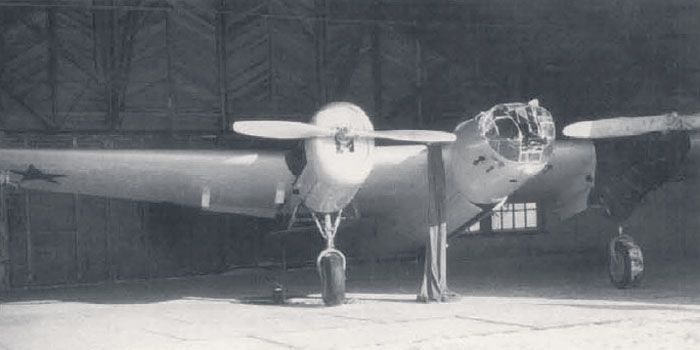
SB 2M-100 c/n 4287 in Soviet Far East during the winter 1937/1938.
It was damaged because of a collision with another plane during a takeoff.
This plane appears painted in overall light grey, probably the AE-9 enamel introduced in 1937.
(from TUPOLEV SB, M.Maslov, ed. Ikarus)
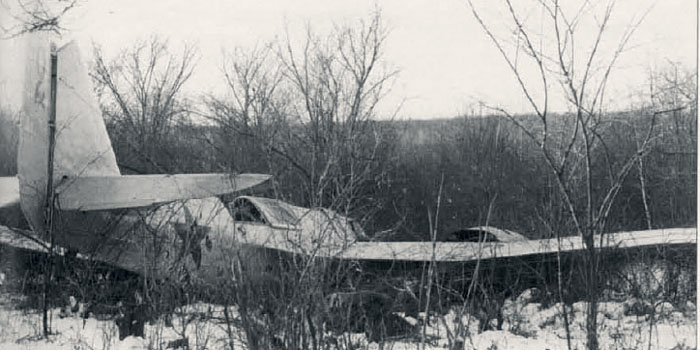
Another early SB 2M-100 c/n 2270, in Soviet Far East. The plane features a (yellow?) 2 on its rudder, and looks painted in light grey.
(from TUPOLEV SB, M.Maslov, ed. Ikarus)
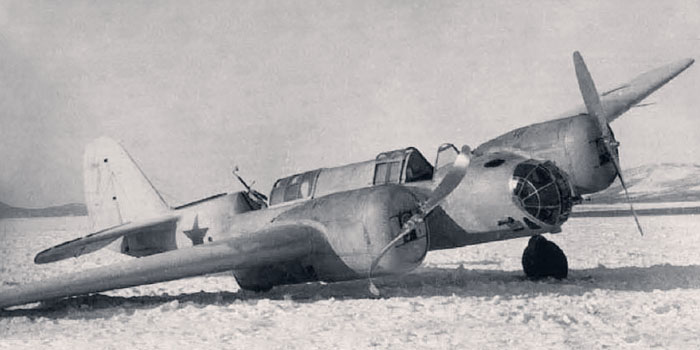
The SB c/n 2282 yellow (?) 7 of 60th Aviation Squadron flown by B.M. Andreev at Voskresensk Airfield, January 1938. Its look is interesting because of the disuniformity of the colors, probably modified over a light grey base; part of the uppersurface was oversprayed with very thinned green spaghetti; then the tail, rear fuselage and wing tips seem repainted in white to match the snowy ground. Note the unpainted frames of the nose windows.
(from TUPOLEV SB, M.Maslov, ed. Ikarus)


Rare photo of a two-bladed SB 2M-100 in 1941, during the German invasion. It has been repainted with A-19f gloss green uppersurfaces and A-18f undersurfaces according to the standards of May 1940, while the nose windows frames seem unpainted..
Note the black venturi on the nose; this detals was usually left painted black.

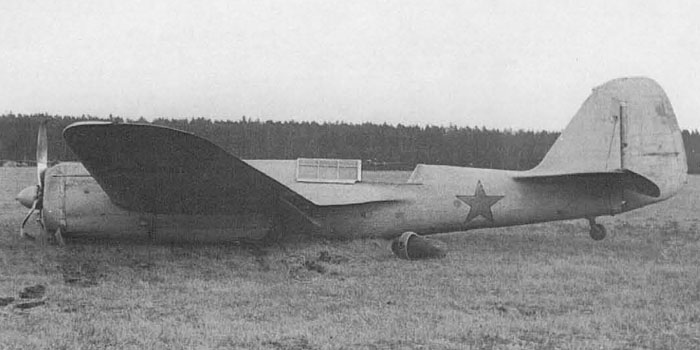
SB 2M-100 n.163 after an emergency landing in Podlipki airfield on November 1939, due to the collapse of a landing gear.
Interestingly, the plane shows the three-blades VISh propeller that became standard on planes equipped withy M-100A and M-103 engines. It's unclear if this is due to a refitting, or the plane was built in this way.
The plane is unarmed, and tthe slots for the guns on the nose glazing are covered by clear stripes.
Note the non-uniform grey painting, and the apparently unpainted framing.
Images from Tupolev SB of Maslov.
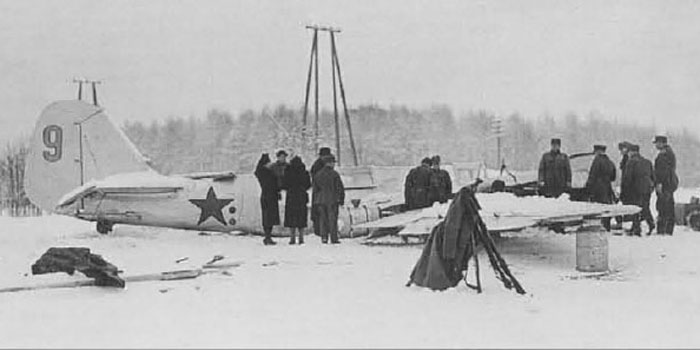
SB 2M-100 n.20/101 of 41 BAP shot down by Finnish fighters on December 1, 1939. The plane was described by different sources as 'blue 9' or 'yellow 9', and here appears as partially dismantled.
The plane seems equipped with a mirror atop the windshield, probably a refitting, and three-blades propellers.
From Tupolev SB of Maslov
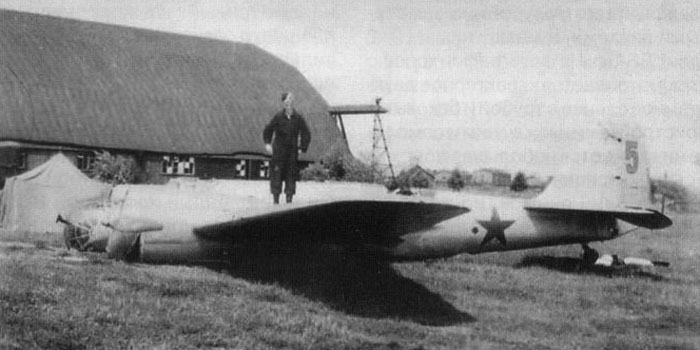
Rare image of SB 2M-100 with two blades propellers during the German invasion of 1941. The number 5 looks yellow or light blue with black outline.
The livery is light grey overall.
The typical variant produced during 1937 was equipped with the improved engine M-100A and VISh-2 three-blades variable-pitch propellers; they were not provided with the underwing bomb racks introduced in later models.
Note that many SB 2M-100 were equipped or refitted with three-blades propellers; so, these variants could be easily misidentified; it's not possible to know for sure the engine type from the outside.

Unsatisfied with the durability and smoothness of AE-9 grey enamel on the anodized duraluminium surface, the technicians of Factory n.22 started to paint the SB with aluminium enamel AE-8 for a period of 6-12 months during 1938 (and perhaps the end of 1937).
Later, they reverted to AE-9 light grey.
The aluminium finish was employed only on some SB 2M-100A and early M-103.
 AE-8
aluminium: oil enamel utilized to paint SB during some months in 1938.
AE-8
aluminium: oil enamel utilized to paint SB during some months in 1938. 
SB 2M-100A during the Winter War against Finland in 1939. It was equipped with non-retractable skis. The number on the tail gives the idea of a thin, angular 9. Note the unusual conical spinner.
from Tupolev SB of Maslov.
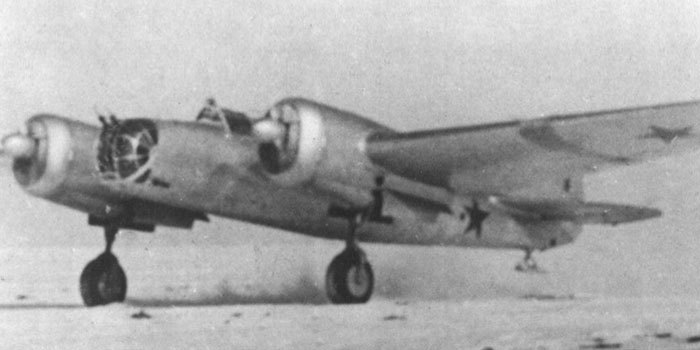
Another image of an aluminium-painted SB, apparently red 1 or black 1. It features painted recognition stripes (yellow or light blue?) on its wings.
Note the mirror atop of the windscreen, typical of SB M-103, but the single circular window on the fuselage sides suggests a plane of 1937 or early 1938, perhaps equipped with M-100A engines.

The tail of a SB shot down by Finns in winter 1939/40. The single circular window on the side suggest an early production plane of late 1937/early 1938 with engines M-100A and silver finish. The red (?) 12 looks overposed to some lighter number or background; there is a cap with some bright color on the rudder.
From Tupolev SB of Maslov, ed. Icarus
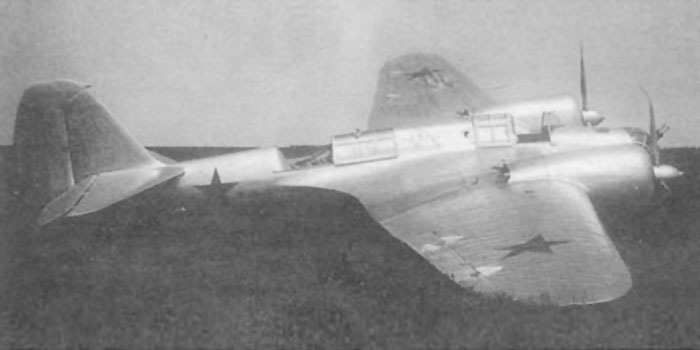
The engine M-103 was introduced into production SB at the beginning of 1938. This type introduced some further improvements:
fitting of a bomb rack under each wing inside the nacelles, each capable to bring a 500 kg bomb, an auxiliary tank or a gas dispenser;
a mirror atop the pilot's windscreen, that was higher; mirrors were fitted outside the usual 'low' windscreens too.
The plane introduced in this period preserved the same frontal coolers and TUR-9 gunner's turret of SB M-100A, and are hardly distinguishable, if not undistinguishable, from them; the ball-like turrets MV-3 and the ventral extendable gun support MV-2, although successfully experimented in the summer of 1937, were introduced into production much later.
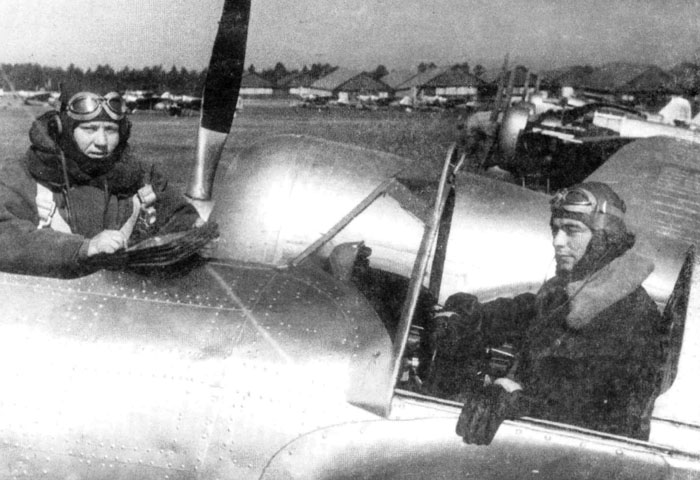
An aluminium painted SB M-103.
The image shows clearly the 'tall' windscreen covering a mirror. This variant looks to be factory built; other SB seem to have a mirror fitted externally to the previous 'low' windscreen, perhaps a refitting on older types; it could be that the mirror at the top was utilized to refit older planes with M-100 and M-100A too.
(from Airwar 065)
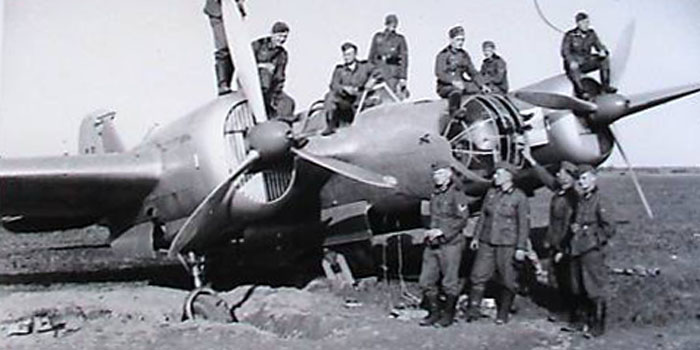
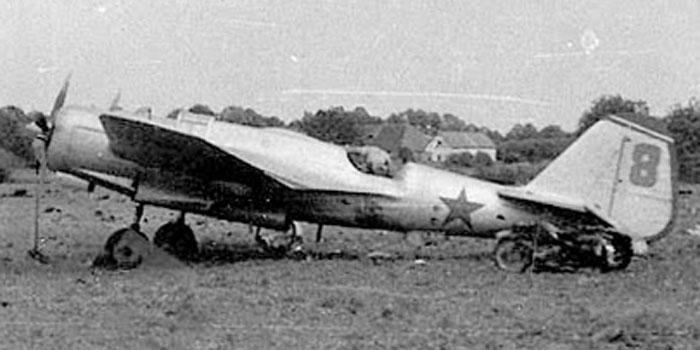
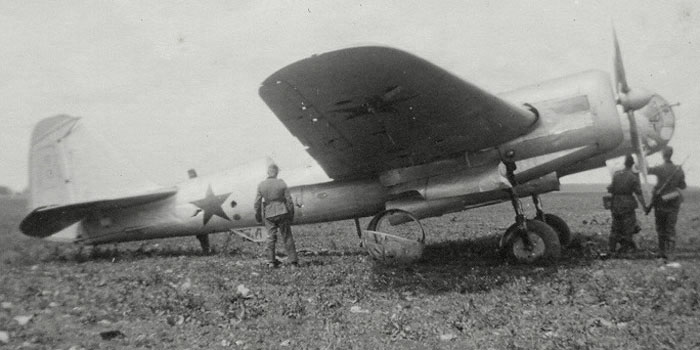
The sameplane from the other side.
The markings on the tail include a yellow (?) 8 with black outline, and a cap of another color on the rudder.
The dismanted turret lies on the ground.
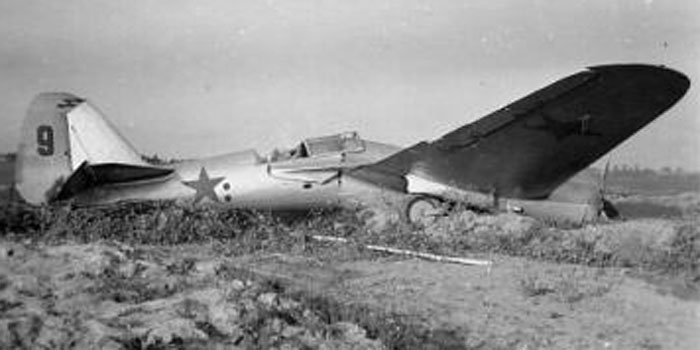
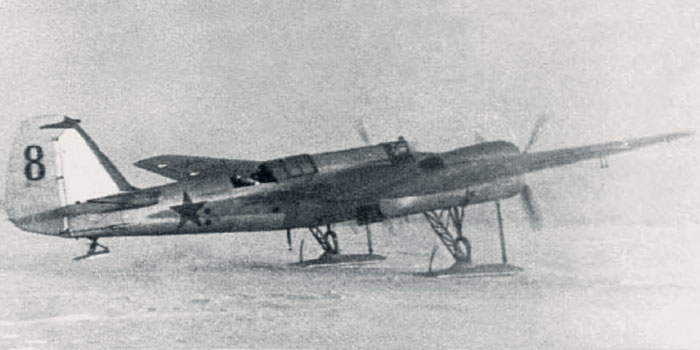
SB 2M-103 fitted with non-retractable ski landing gear in Winter 1939-40. The aluminium finish, the number 8 and the (red?) trimming on the tail are noteworthy.
Note that the landing gear bays and the opening behind the nacelle are all closed by a cover that has small openings for the struts, and two torches mounted under the right wing.
The plane features the typical mirror atop of the windshield characteristic of M-103 engined SB, or perhaps one added on as a refitting.
(from TUPOLEV SB, M.Maslov, ed. Ikarus)
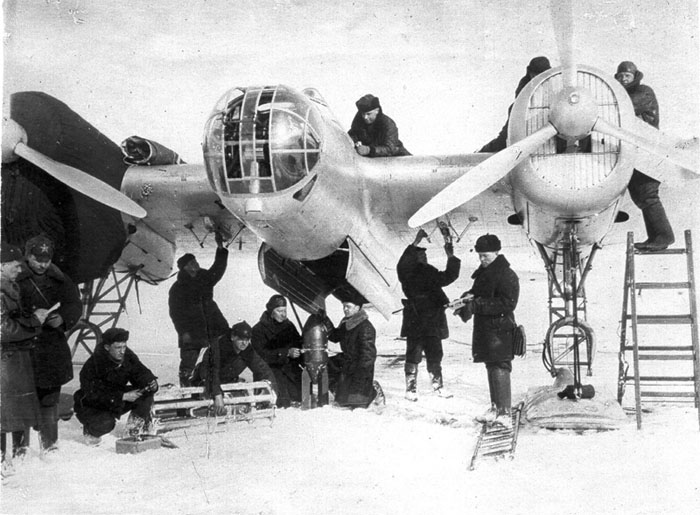
A SB 2M-103 (recognizable for the tall windscreen with mirror) during the Winter War.
It's unclear if the finish was silver or grey.
The image shows many details of the non-retractable ski landing gear and of the doors closing the bays, of the underwing bomb racks introduced with this type.
On this plane, the slots for the frontal machine guns are fully open.
http://www.bellabs.ru/Fotab/Sov-Fin/Sov-Fin.html
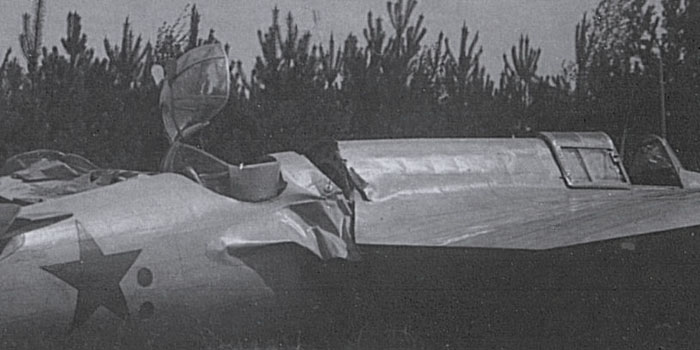

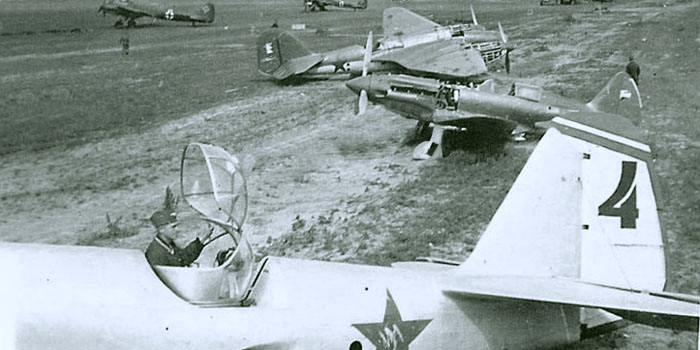
SB black 4, presumably with flat-coolers M-103 engines (the combination light grey-ball turret-flat cooler seems more common in photos than the sharp-engined variant). The cap and nails painted on the tail could be red.
On the background, a MiG-1 and an Ar-2 whose udders have been vandalized by souvenir hunters.
The use to mottle the light surface of SB, as well of I-153s and other types, started in summer1939 during the Khalkin-Gol war against Japaneses, when the planes of the 100th Aviation Brigade had green mottling or wavy lines painted on them. However, a very thin pattern of green lines seem visible even on a photo dated in winter 1938.
The use was extended to other units too, so, at the war outbreak, many SB showed green (and sometimes black) mottles or wavy lines over their original light livery.
 AII
green: gloss nitro paint introduced in 1938 and widely utilized on mixed
construction planes as I-16. It's usable over a primed metallic surface,
and is the most likely color for mottles.
AII
green: gloss nitro paint introduced in 1938 and widely utilized on mixed
construction planes as I-16. It's usable over a primed metallic surface,
and is the most likely color for mottles.
The oil paint AE-7 is supposed to be very similar.
 Early
olive green utilized before 1935 or 1937: possibly utilized for mottles.
Early
olive green utilized before 1935 or 1937: possibly utilized for mottles. 3B
dark green: oil paint utilized for army vehicles and, in unknown extent, on
metallic planes in 1935-37. Possibly utilized for mottles.
3B
dark green: oil paint utilized for army vehicles and, in unknown extent, on
metallic planes in 1935-37. Possibly utilized for mottles. Black:
possibly utilized for mottles and stripes aside greens.
Black:
possibly utilized for mottles and stripes aside greens. AE-9:
gloss light grey oil enamel, the common base color of SB.
AE-9:
gloss light grey oil enamel, the common base color of SB. AE-8
gloss aluminium old paint: believed to be utilized as a base color only on
some SB built in 1938.
AE-8
gloss aluminium old paint: believed to be utilized as a base color only on
some SB built in 1938.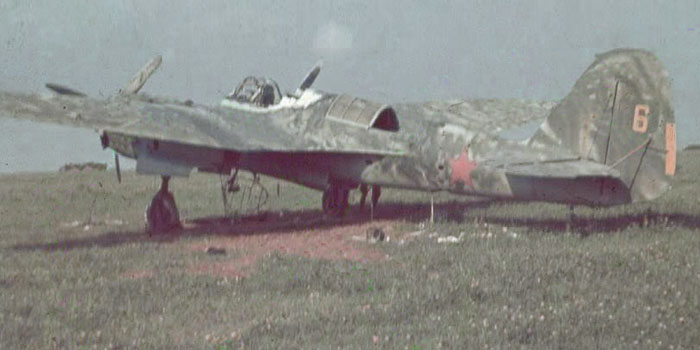
An exceptional color image shows the use of at least two shades of green to camouflage this plane over its light grey base.
The photo undoubtedly confirms the use of yellow for marks before the war outbreak. After the summer 1941, yellow was abandoned because Germans and their allies utilized it as an identification color.
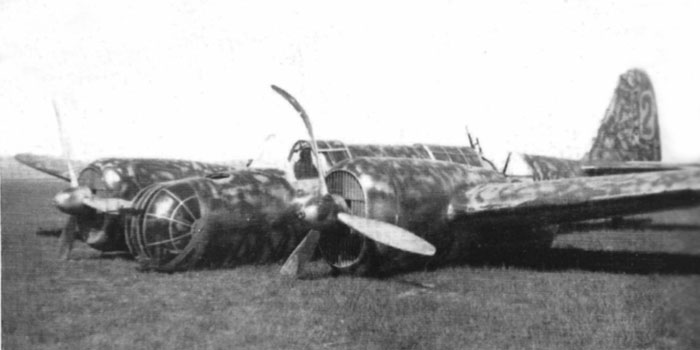
This SB 2M-103 (note the tall windshield) of 38 SBAP of the 100th Aviation Brigade made an emergency landing in 1939 in Mongolia.
Note the wavy pattern overposed to the original grey or aluminium finish.
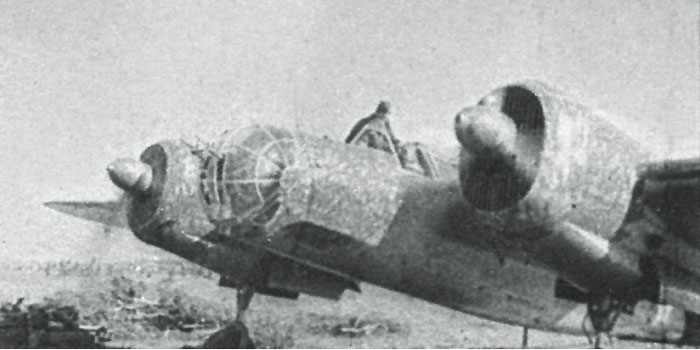

Another SB (apparently red 4) is being pushed by ground crew. Its camouflage looks made with green brush strokes.
The front of the spinners looks painted red.

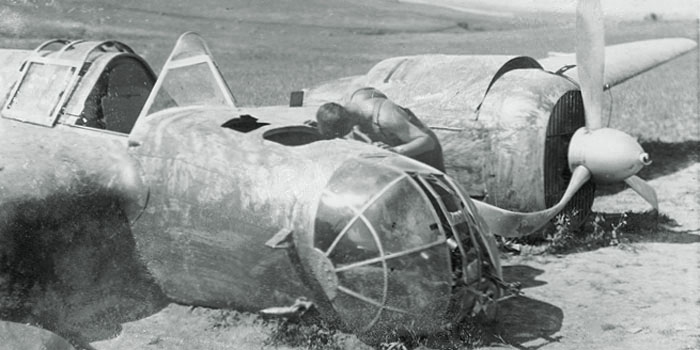
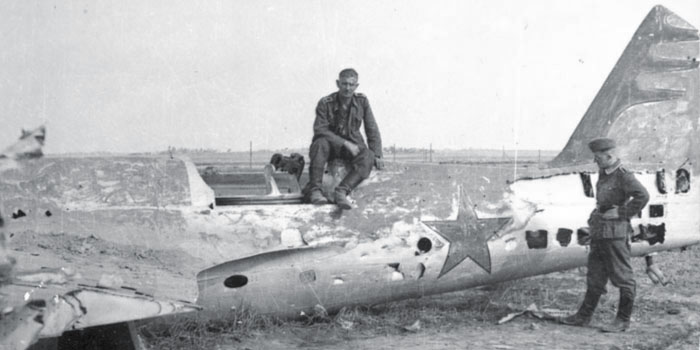

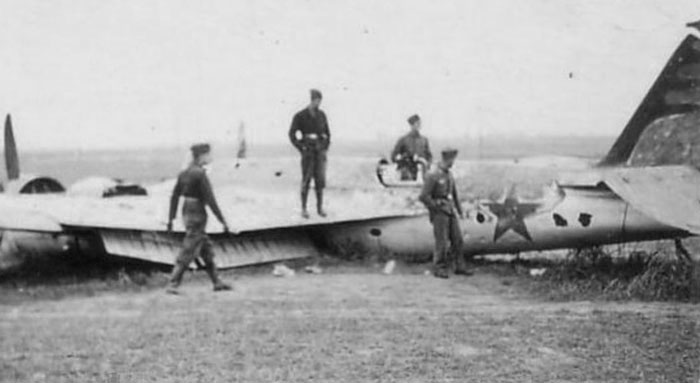
Some SB M-100A or 103 of the same unit, shot down by Germans. Note the red decoration on the stabilizator's leading edges, and the green brushed camouflage over the aluminium background.
Red 1 and red 5 are recognizable on the rudders of some of these planes.
Red 5 has two strange supports of unknown use on the right side of its nose.
The planes should be of early production, late 1937 or beginning of 1938, as suggested by the single circular window on the fuselage sides; twin winfdow was introduced in production in 1938. So, the engines of these planes could be M-100A.

Another wreck showing its silver fuselage roughly brushed with green paint.
Note a strange mark on the top of the rudder.
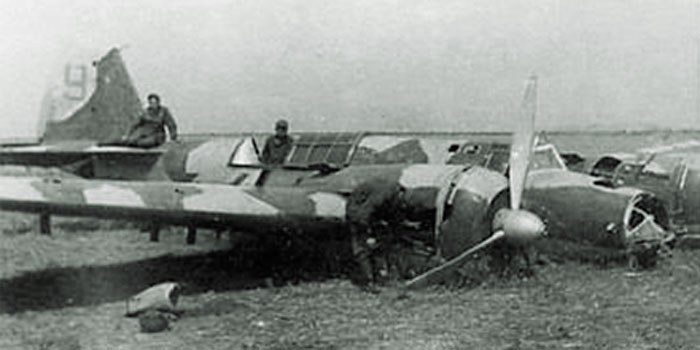
This SB 2 M-103, yellow (?) 9, was camouflaged with wide angular bands of green on its light grey background.
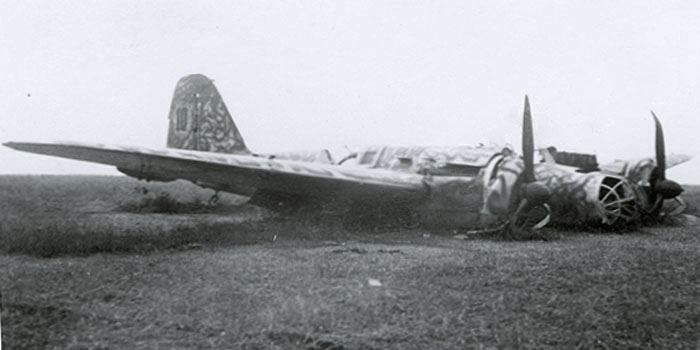


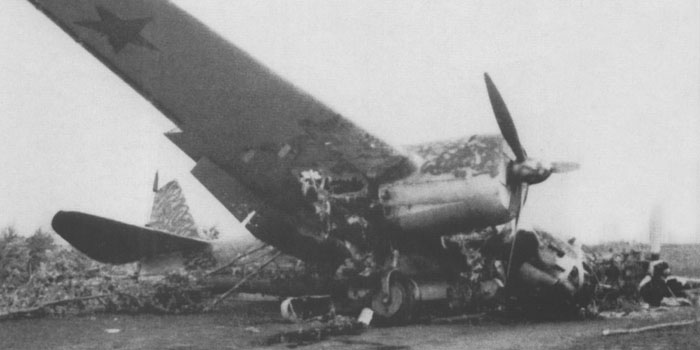

These images taken in Kiev military district in July 1941 show a wavy camouflaged SB 2M-103 with AE-8 aluminium background, probably built in 1938.
Note, on the rudder, the red number 1 inside a green circle, and the small starlet with black outline.
From Monografie Loctnitze n.083
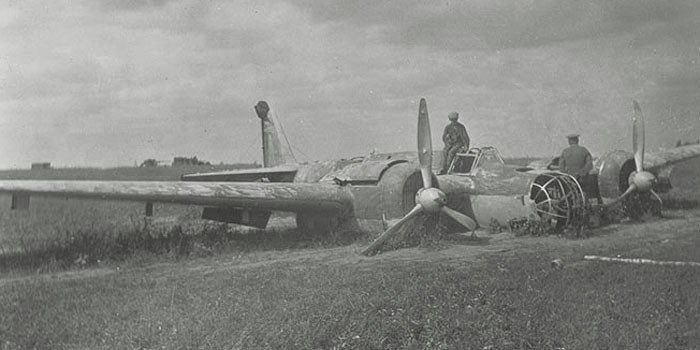
Camouflaged SB 2M100A with red starlets on the spinners. It's unclear if its a camouflage of light color on a green background, maybe the remain of a winter camouflage, or what else.
The combat planes built between June 1940 and July 1941 conformed to a new standard, with gloss green A-19f uppersurfaces and gloss light blue A-18f undersurfaces.
The existing planes had to be repainted in green on their uppersurfaces, leaving the undersurfaces of the previous color, AE-9 in the case of the sharp-engined SB. Only a part of the existing planes was subject to such repainting.
Often existing planes were left with their original light grey livery, sometimes mottled or striped with green and eventually black or other colors, as in use in some units since the wars against Japaneses.
The prop blades continued to be left unpainted on their front face, with the rear face partially painted black.
 A-19f
green: utilized for all the upper and side surfaces of all-metal planes as
the SB. It's believed that it was prone to a quick fading to a grass green,
although preserving the gloss finish.
A-19f
green: utilized for all the upper and side surfaces of all-metal planes as
the SB. It's believed that it was prone to a quick fading to a grass green,
although preserving the gloss finish.
 A-18F
light blue: color of the undersurfaces of all metal planes, as SB, built after
June 1940.
A-18F
light blue: color of the undersurfaces of all metal planes, as SB, built after
June 1940. AE-8
aluminium oil enamel: base color for many planes built in 1938. Possibly preserved
as a color for undersurfaces.
AE-8
aluminium oil enamel: base color for many planes built in 1938. Possibly preserved
as a color for undersurfaces.  AE-9
light grey: the color previously utilized for overall painting before June
1940 was preserved even on the undersurfaces of the planes, even if their
uppersurfaces were repainted in green.
AE-9
light grey: the color previously utilized for overall painting before June
1940 was preserved even on the undersurfaces of the planes, even if their
uppersurfaces were repainted in green. 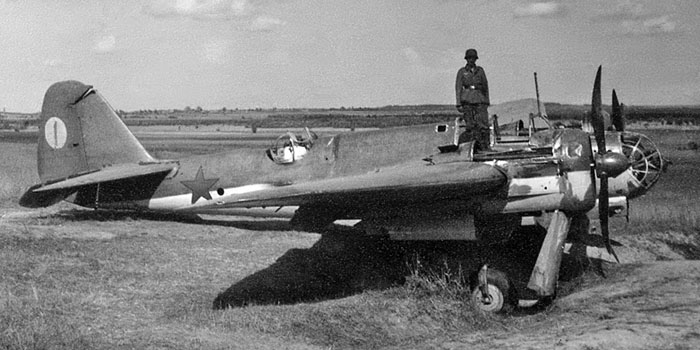

Below: this SB with frontal radiator and MV-3 turret, windscreen mounted antenna mast) looks a good example for the May 1940 scheme. It's likely that this version with frontal coolers was already out of production in June 1940, and that the green painting, the antenna mast and the MV-3 turret are due to a refitting. The irregularity in the skinning in front of the turret seems to support this idea.
In this case, it's likely that the plane preserved the light grey AE-9 undersurfaces after the painting of uppersurfaces with A-19f alkyd green, instead of repainting them with AE-18 alkyd light blue.
The prop blades apper painted in black, while the spinners seem painted in red. The red (?) 1 on a round yellow (?) background is noteworthy, and probably indicates the squadron leader.
image by Piotr Biskupski

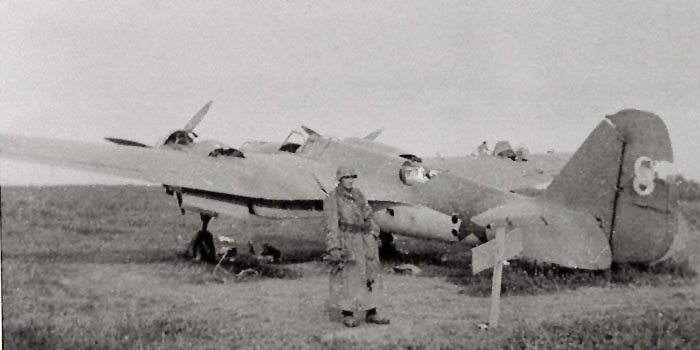
Another SB 2 M-103, yellow (?) 8, with frontal coolers and the typical recess for a MV-3 turret (that appears removed or broken). The star on the fuselage appears unusually large. Again, some irregularities in the skinning in front of the turret suggest that the skinning and turret themselver were refitted on a plane built with the earlier gun position, and then repainted according to the newer standard, probably leaving the uppersurfaces with the previous AE-9 light grey finish.
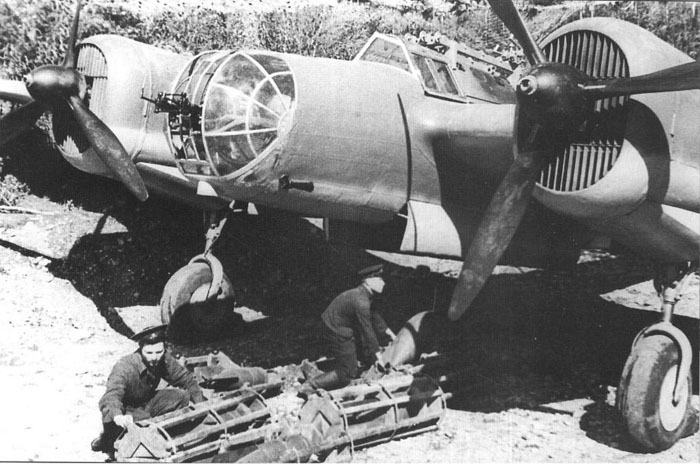
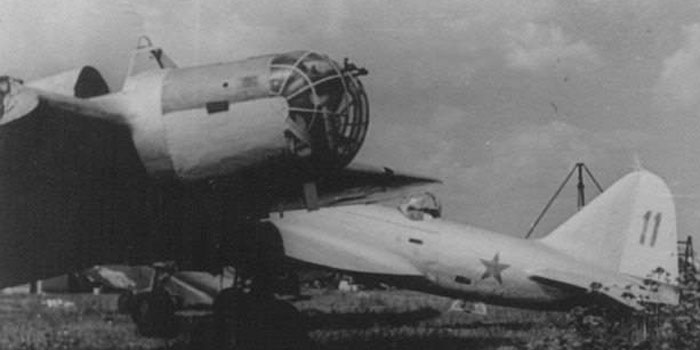
Interesting image of partially dismantled SB 2M-103; its nose shows a green/light blue finish, mounted on a plane with silver finish. The nose was easily replaceable to mount the USB one, often supplied as an option to be instelled on existing planes.
image courtesy Jan Konnig
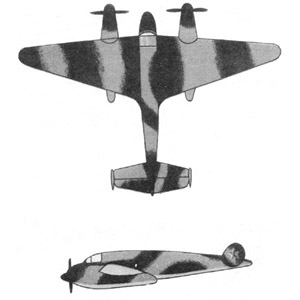 On
20 June 1941, the last day of peace, it was published an order of NKAP (the
Ministry for Aeronautical Industry) to paint all planes with a new standard
camouflage within one month.
On
20 June 1941, the last day of peace, it was published an order of NKAP (the
Ministry for Aeronautical Industry) to paint all planes with a new standard
camouflage within one month.
For newly built planes, the instructions said to utilize matt light blue for undersurfaces (not specified what type of paint, but all previous light blue paintings were gloss, so they have to be A-28m for all-metal planes and AMT-7 for mixed construction planes).
Apart for some Yaks, the first known photos of planes with the new green/black painting scheme are dated to July 13, 1941.
Many maintenance manuals of the first years of war describe these paints: dope AMT-4 green, AMT-6 black and AMT-7 blue enamel or oil A-24m, A-26m and A-28m of the same colours. Oil colors were less utilized, also because AMT colors can adhere well to primed metal surfaces.
Despite their name (M= matt), AMT colors were semigloss when new, and turned to matt finish with ageing. Occasionally, they could have been overpainted with a layer of gloss varnish AB-4-d to improve aerodinamicity and gain some speed.
While AMT-4 and 6 were codified in July 1941, AMT-7 was codified in August 1941, and is not mentioned on earlier manuals; earlier AII light blue remained in use in parallel with the darker AMT-7 in the first years of war.
Oil enamels were intended to be sprayed on the exterior metal surfaces, even unprimed. Painting with a brush meant poor paint properties, and was allowed only as a second choice, ex. for repairs.
Prop blades were now fully painted black.
The order of June 1941 changed the national marks of planes too. Red stars, of plan tipe or with thin black outline, were now placed in four or six positions:
- one on each side of fuselage (not always),
- one on each side of rudder/stabilizer,
- one on the undersurface of each wing (lower wing, in case of biplanes).
Note the deletion of stars over the wings, and the introduction of new ones on the tail.
The release of a clear directive on camouflaging the planes with green and black bands, with light blue undersurfaces, reached the units contemporarily with the war outbreak, when the frontline units had other things to worry about.
The directive previded that the existing planes, already painted with a layer of green on uppersurfaces (both AII green, A-19f or earlier types of protective), had to be painted with black bands, eventually preserving the original green and the original color of undersurfaces.
The red stars on the upper face of wings were usually obliterated with camo colors, and new stars were added on the sides of the tail in addition to those on the fuselage.
 A-19f
green: the standard gloss green for uppersurfaces between June 1940 and July
1941. Easily preserved as a base color after the war outbreak. It's believed
to be dark when new, and to fade quickly to a lighter shade preserving the
gloss finish for a relatively long time.
A-19f
green: the standard gloss green for uppersurfaces between June 1940 and July
1941. Easily preserved as a base color after the war outbreak. It's believed
to be dark when new, and to fade quickly to a lighter shade preserving the
gloss finish for a relatively long time. A-18f:
gloss light blue for undersurfaces between June 1940 and July 1941. Easily
preserved as color of the undersurfaces.
A-18f:
gloss light blue for undersurfaces between June 1940 and July 1941. Easily
preserved as color of the undersurfaces. AMT-4:
the standard matt green for new-built mixed construction planes. Possibly
utilized to repaint some SB.
AMT-4:
the standard matt green for new-built mixed construction planes. Possibly
utilized to repaint some SB. AE-9:
gloss light grey oil enamel, the common base color of SB till June 1940. Easily
preserved as color of the undersurfaces..
AE-9:
gloss light grey oil enamel, the common base color of SB till June 1940. Easily
preserved as color of the undersurfaces.. A-24M:
oil equivalent of AMT-4, utilized for all-metal planes. Possibly utilized
to repaint some SB.
A-24M:
oil equivalent of AMT-4, utilized for all-metal planes. Possibly utilized
to repaint some SB. AE-8
aluminium oil enamel: base color for many planes built in 1938. Possibly preserved
as a color for undersurfaces.
AE-8
aluminium oil enamel: base color for many planes built in 1938. Possibly preserved
as a color for undersurfaces.  AMT-6:
the standard matt camouflage black, usable both aside AMT-4 and over A-19f
green to camouflage old planes. It was not 100% dark, particularly if utilized
in a thin layer or faded.
AMT-6:
the standard matt camouflage black, usable both aside AMT-4 and over A-19f
green to camouflage old planes. It was not 100% dark, particularly if utilized
in a thin layer or faded. AMT-7
matt light blue: standard for undersurfaces of newly-built planes after June
1941. Possibly utilized to repaint the undersurfaces of some old planes.
AMT-7
matt light blue: standard for undersurfaces of newly-built planes after June
1941. Possibly utilized to repaint the undersurfaces of some old planes. AMT-1
matt light brown: occasionally utilized in 1941-43 for non-standard camos,
became standard on non-fighter planes after the August 1943.
AMT-1
matt light brown: occasionally utilized in 1941-43 for non-standard camos,
became standard on non-fighter planes after the August 1943. AII
gloss light blue: standard color for new-built mixed-constructon planes (not
for all metal SB, then) between July 1940 and June 1941, also utilized after
that date as an alternative to AMT-7. Possibly utilized to repaint the undersurfaces
of some old planes.
AII
gloss light blue: standard color for new-built mixed-constructon planes (not
for all metal SB, then) between July 1940 and June 1941, also utilized after
that date as an alternative to AMT-7. Possibly utilized to repaint the undersurfaces
of some old planes.
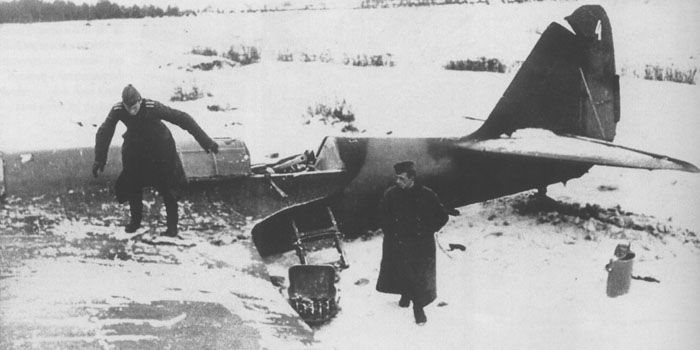
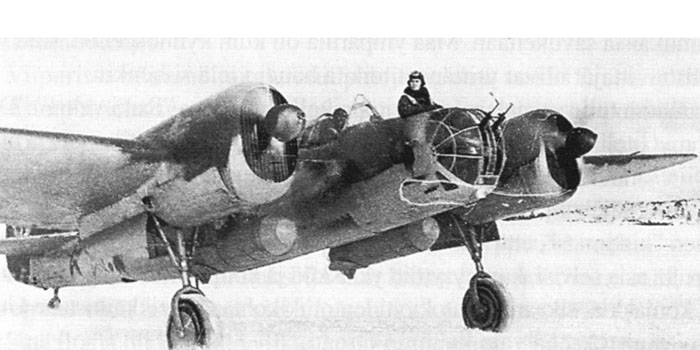
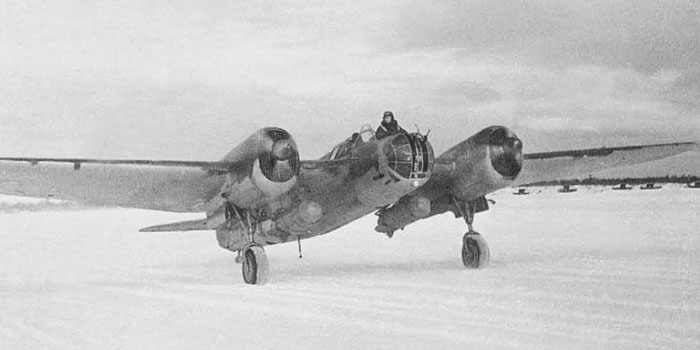
SB 2M103 of the 72nd SAP of the Nortern Fleet. The plane looks camouflaged with large green and black patches that probably let to see some of the original light grey background on the uppersurface. The prop blades looks to have preserved their unpainted shiny surface.
Two 250 kg RRAB-3 (rotative- scatter) bombs are well visible under the wings.
The navigator is protruding to observe around while taxiong, because the engines limited the side visibility of the pilot.
Bombs were usually painted in a medium grey shade.
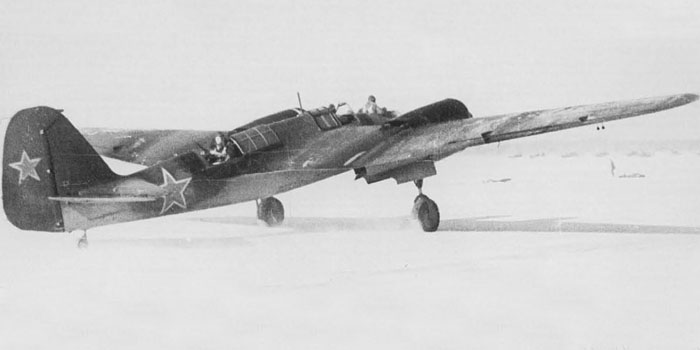

SB 2M-100 in LII (Flight Test Institute) airfield in winter 1943/44.
The camouflage looks AMT-6 black and AMT-4 green, with some fresh black repainting on the engine cowlings and other parts. Surprisingly, the prop blades have preserved their ancient finish: unpainted on the front, painted black on the rear except of their root.
The stars have the white-red outline introduced in the late summer of 1943.
The plane features two unusual aerial masts above and below the fuselage.
Two torches are mounted under the right wingtip.
From Tupolev SB of Maslov
 MK-7
white distemper: made with chalk and casein glue, it assumed a very rough
surface.
MK-7
white distemper: made with chalk and casein glue, it assumed a very rough
surface.
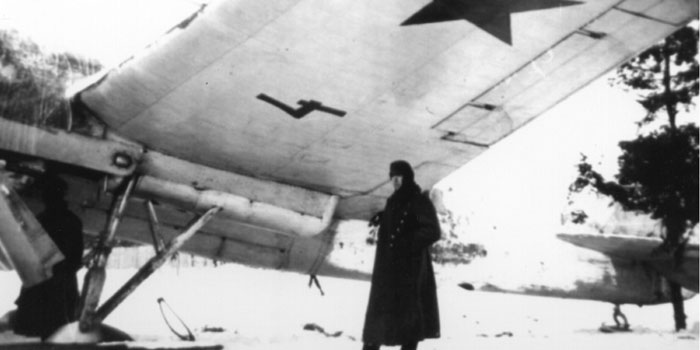
A SB with an improvised winter camo over an improvised summer camo. The number 4 painted under the wing is unusual.
Note the replacing of the doors with a closed cover that closes thebay and the back of the nacelle, and has openings for the landing gear struts.